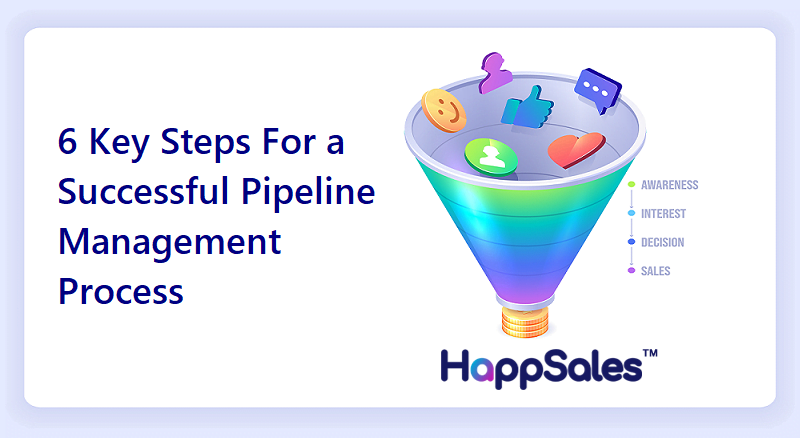Last updated on January 24th, 2025 at 01:42 pm
Introduction
A structured pipeline management is the lifeblood of successful sales organizations. It serves as a guide to sales team members in the complex journey of converting leads into customers. Benefits of having robust pipeline management are manyfold.
This article details the 6 key steps involved in establishing a successful pipeline management process and system. It also discusses the best practices required for an effective sales strategy and how to manage your sales pipeline effectively.
![]() Related Read – What is pipeline management in sales?
Related Read – What is pipeline management in sales?
6 Key Steps in Effective Pipeline Management
Define sales stages
This is the first step in the pipeline management process. It is important to define and identify the different sales stages involved in how a prospect moves through from an initial contact all the way till the lead gets converted into a paying client. Some of the common stages include Lead, Qualified, Demo, Proposal, Negotiation, and Won or Lost. Defining these stages ensures a standardized approach to the sales process. It also helps the sales reps to have an understanding of important actions required to progress the deal through the pipeline.
Categorize sales stages
This is the second step in the pipeline management process. As a next step, it is a good idea to categorize the sales stages into various groups. This helps your sales and marketing teams to understand the current stage of the prospect and what steps to be taken to nurture the deal further.
Here is an example of the common categories that you may use –
- Demand generation – this stage involves you to create awareness about your company and offerings among your target audience
- Lead qualification – this involves qualification of your leads through a structured process. One such effective technique is called BANT lead qualification which we will discuss in the later section. This allows your team to invest their time and efforts only on the right prospects based on factors like budget, authority, need, timeline, solution fitment, etc. That way, only the qualified leads move further down the pipeline.
- Deal nurturing & closure – once qualified, your sales teams need to plan a set of sales activities to further nurture the deal and progress it to the closure stage. The steps here could include client meetings, demos, proposal submission, and negotiations.
The above categories are also referred to as –
- Top of the Funnel (TOFU)
- Middle of the Funnel (MOFU)
- Bottom of the Funnel (BOFU)
Identify criteria for deal progress through the pipeline
Next important and third step in the pipeline management process is to identify the criteria for each stage’s progression. It is important to set clear benchmarks and criteria required for prospects to move from one stage to the other. These criteria could be based on involvement by decision makers, budget approvals, overall account mapping, etc. It is suggested that you provide ample training to your sales reps so that everyone understands when to progress a deal to the next stage.
Assign specific roles and responsibilities for each of the stages
Each stage in the pipeline management process involves different stakeholders with different sets of sales activities and skill sets. Therefore, it is important to assign roles and responsibilities for every stage. For instance, the marketing team may be responsible for demand generation, sales development representatives manage lead qualification and account executives are responsible for deal nurturing and closure. Thus, clearly defining their roles and responsibilities will improve collaboration, higher accountability, and a much more efficient sales process.
Implement effective sales forecasting process
One of the most important steps of a robust pipeline management process is better and accurate sales forecasting. Sales forecasting process could be one of the below or a combination of it –
- System generated sales forecast: CRM system calculates the sales forecast based on the deal details like deal value, closure probability, total sales pipeline, weighted pipeline, etc.
- Manual sales forecast: wherein every rep gives their individual sales forecast along with their best-case and worst-case scenarios.
Periodic cadence and review process
This step in the pipeline management process is very crucial to maintain an agile and adaptive sales process. Having a cadence mechanism and periodic reviews are very important to streamline your sales process and create a well-oiled sales machine. It helps you to identify different areas of improvement and take proactive steps. This helps businesses to continually improve and optimize their sales efforts and costs.
 Bonus Tip: Sales pipeline strategies to grow revenue!
Bonus Tip: Sales pipeline strategies to grow revenue!
Best practices for effective pipeline management process in sales
In today’s fast-paced competitive environment, we need to follow certain best practices for the sales pipeline management process to become successful. Let us discuss some of them.
Define your goals
The first and foremost aspect is to clearly define your objectives with clear and measurable goals. You need to work closely with different stakeholders and team members to establish realistic goals and targets for all of them. It is also important to ensure that these goals are aligned with the company’s overall business goals.
Consistent demand generation
A steady flow of qualified leads is the lifeline for any business to succeed. An established demand generation strategy includes both inbound and outbound tactics. Email campaigns, LinkedIn campaigns, SEO, content marketing, etc. are all very powerful tools that help generate leads for your business. Consistency in these efforts ensures a steady flow of leads into your pipeline.
Stringent lead qualification through techniques like BANT
Effective lead qualification is like sorting the wheat from the chaff. It is important to differentiate between good and bad leads using lead qualification techniques like BANT which considers parameters like Budget, Authority, Need, Timeline, Solution Fitment etc. This helps you to identify the right potential prospects so that your sales reps could optimize their efforts on these right leads who are more likely to convert into customers.
Prioritize deals
Prioritization of deals is one of the essential best practices that any company must follow. This helps you to focus on revenue-generating opportunities to drive sales efficiency and growth . This will help your sales team members to optimize their efforts well and focus on the right deals. You would be able to now allocate your resources wisely while keeping your customer acquisition costs (CAC) low.
Leverage sales automation tools
In a super competitive environment, sales automation tools like CRMs have emerged as a game-changing strategy for companies. Using a CRM software like HappSales, you can automate all the manual and time consuming tasks allowing businesses to focus on much more productive activities that will help you generate more revenue consistently. By leveraging sales automation tools, you can gain valuable data-driven insights into your pipeline performance and deal progress. Metrics like sales velocity, deal win-rates, sales cycle time, etc. can be easily and accurately measured and improved. Sales tools like a mobile CRM app can significantly improve your sales team’s productivity and efficiency.
Maintain CRM discipline
Maintaining CRM discipline to keep the data up-to-date is a fundamental pillar in the context of best practices to manage your sales pipeline. CRM provides valuable insights into leads, opportunities, sales performance, and customers. Diligently updating the data ensures accuracy and enhances the efficiency of the overall sales pipeline. Using up-to-date information helps sales reps to engage with clients in a more personalized and informed manner. Moreover, only updated current data can give you the right assessment of the health of your sales pipeline. Not updating data regularly leads to missed opportunities, miscommunication and decline in overall sales productivity.
Measure and track metrics consistently
Define clear KPIs (Key Performance Indicators) for your team members for every stage of the sales process. Metrics like lead conversion rate, average deal size, average sales cycle, rolling four quarters pipeline, etc. provide valuable insights into sales performance. Regularly analyzing these metrics and identifying areas for improvement will help you mitigate risks early and drive predictable sales performance.
Continuous training
Investing in professional development of the sales reps through continuous training programs is important. Continuous updates on industry trends, product knowledge, negotiation skills and communication techniques are very essential for successful sales. A well-trained sales team adapts better to changes and offers more personalized solutions to potential customers and instills confidence in them.
Conclusion
In summary, in this fast paced sales environment, efficient pipeline management is the cornerstone of success. By leveraging these steps and best practices, you can easily scale up your performance. Meticulous lead management and gradually nurturing them into qualified opportunities stand as the roots of growth. Enhanced sales activities coupled with active communication and collaboration propel the pipeline to move forward. As your sales pipeline flow gets fine-tuned, it brightens up the path ahead making it much easier for the sales team members to close deals and grow revenue.
A robust sales strategy is crucial to managing your sales pipeline effectively, ensuring that each prospect is handled appropriately towards closure.
Author Bio
Author Name: Deepa Arul
Deepa leads Marketing Operations at HappSales. She comes with over a decade of vast experience in sales and marketing operations.
She is obsessed with customer success, and loves writing blogs on sales & marketing topics. During her free time, you can find her mastering the French language. She actively contributes to the society by recording audiobooks to the visually challenged and teaching English to the underprivileged children, in addition to her favorite pastimes of reading and traveling.



